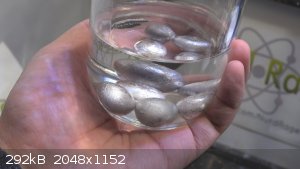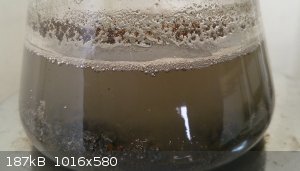| Pages:
1
..
11
12
13 |
JJay
International Hazard
    
Posts: 3440
Registered: 15-10-2015
Member Is Offline
|
|
Tomorrow, NurdRage is uploading his video on his new technique for making sodium. I can hardly wait.

|
|
|
j_sum1
Administrator
       
Posts: 6320
Registered: 4-10-2014
Location: At home
Member Is Offline
Mood: Most of the ducks are in a row
|
|
Woohoo!
I think I will buy a few hundred grams of Mg in readiness!
|
|
|
j_sum1
Administrator
       
Posts: 6320
Registered: 4-10-2014
Location: At home
Member Is Offline
Mood: Most of the ducks are in a row
|
|
And, If I am not mistaken, I think this is the definitive work.
https://www.youtube.com/watch?v=jCrFFVVcPUI
Kudos to Nurdrage for his efforts. This really is the most promising thing I have seen in... well ever. It looks so much tidier than electrolysis of
molten NaOH or any other methods I have seen.
|
|
|
JJay
International Hazard
    
Posts: 3440
Registered: 15-10-2015
Member Is Offline
|
|
Definitely very cool. I am going to have to make some dioxane when I get my fume hood built.
|
|
|
tsathoggua1
Hazard to Others
  
Posts: 335
Registered: 8-1-2017
Location: Beyond the pale
Member Is Offline
Mood: Phosphorescent
|
|
Likewise, JJ. Although I'll work outside for it instead and wear hazmat gear in place of the hood, for this, considering that the initiation of the
magnesiothermic reduction is not something one would want indoors. Happen to have plenty antifreeze that was going to be used for making perc, during
a time when no chlorocarbons were available, but now plenty dichlor is to hand when needed, less can go on to be chlorinated w/ Zn/HCl, trying
Nurdrage's dioxane method for Na separation (and will try with KOH also), got everything needed to make a go at it, just as long as the antifreeze is
ethylene glycol rather than DEG as is sometimes to be found. Although I think I picked up some EG specifically, about a gallon of the stuff.
This is a great discovery, my compliments to Nurdrage for this. Looks like it beats the absolute piss out of the various rather touchy electrolytic
processes.
How prone is 1,4-dioxane to peroxidation compared with diethyl ether, diisopropyl ether, and THF? for longer term storage of a quantity of dioxane
that would be dedicated to this particular purpose, storage over sodium after argon sparging and degassing under vacuum, followed by an argon blanket
over any headspace in the 1,4-dioxane ought to reduce and eliminate peroxides as formed should it not? so if stored over a few nuggets of Na, can the
dioxane not be continually recycled, since refluxing over Na (and the dioxane batch being dedicated specifically to magnesiothermic Na or K
production), it would get regular treatment for peroxides as essentially a side bonus of the process itself taking care of any formed peroxides should
it not?
And two other questions-what is the shelf-life of 1,4-dioxane inhibited with a little BHT or BHA, with or without sodium? And uninhibited dioxane if
not otherwise treated, how long does significant peroxidation take, roughly?
Have you considered, after first pre-drying the dioxane, using an argon blanket over the liquid 1,4-dioxane and storage under Ar to increase shelf
life?
And when using Mg powder (mine is, IIRC 400 mesh, possibly 500) how manageable is the reaction in comparison with that using Mg swarf/turnings? does
the fine grain size not result in a dramatically faster, more energetic reduction of the caustic? I'd sooner nnt have any rapid deflagration/flashover
when attempting this.
I noticed, nurdrage, that he distilled the dioxane to dryness. This is something that I have always had drilled into me, as something never to do with
ethers, does this apply to freshly treated (immediately before use) ethers, when treated for peroxides and distilled under a current of inert gas.
Ordinarily distilling ethers to dryness is or can be dangerous because any peroxides formed already are concentrated and can pose a significant hazard
if present, since once concentrated down there is much less solvent to peroxide ratio, increasing the potential for a big mess that one really
wouldn't want occurring in one's glassware, and less still doing so whilst the experimenter is within range of flying razor sharp glass fragments.
|
|
|
Elemental Phosphorus
Hazard to Others
  
Posts: 185
Registered: 11-11-2016
Location: Is everything
Member Is Offline
Mood: No Mood
|
|
I honestly can say that the risk if peroxides is almost zero if the peroxides are stored over a small amount of sodium and kept in a tightly sealed
bottle. I use Boston round bottles (from Dr.Bob, no less!) to store the relatively small amount of peroxide I have, but really any airtight bottle
should work. As for the speed of the reduction, once I tried burning sodium hydroxide with magnalium (before the whole NurdRage sodium process came
out) and using 200-325 mesh magnalium and coarse to medium hydroxide, and it burnt hot and even after cooling, reacted vigorously with water.
Therefore, I think that with very fine magnesium and powdered sodium, you will boil off some of your yield.
|
|
|
zed
International Hazard
    
Posts: 2283
Registered: 6-9-2008
Location: Great State of Jefferson, City of Portland
Member Is Offline
Mood: Semi-repentant Sith Lord
|
|
This, no doubt, has been posted elsewhere.
Nurdrage has moved on, to an even more do-able Sodium Synthesis.
Not a thermite type reaction!
Just prolonged heating and stirring, with Magnesium, NaOH, a catalyst, and Baby oil.
https://www.youtube.com/watch?v=oiZf-O6vvbE
Kudos!
|
|
|
oberkarteufel
Harmless

Posts: 47
Registered: 11-12-2018
Member Is Offline
Mood: Mayonesium sulfate
|
|
Carry on with active metals...
Some time ago I have tried the thermite-type reaction to produce some sodium.
Some notes for the ones that would want to attempt this also:
- make sure that your reaction vessel will not melt, as a lot of heat is generated.
- make sure that you have a proper fire extinguishing equipment ready, just in case (additional pile of dry sand will also be handy, you can't be too
careful).
- it's a good idea to dig your reaction vessel into the ground to prevent it from tipping over.
- sparklers should be enough to initiate the reaction.
- cover the vessel immediately with a heavy "lid". A brick should be fine.
- a huge fireball may happen anyway, so take away all flammable things from the reaction spot, including yourself.
- SERIOUSLY, DON'T EVEN THINK OF DOING IT INSIDE.
- bigger, un-crushed chunks of "slag" will decrease the yield. Dioxane separation requires small particles.
- it's a good idea to mix the dioxane with NaOH, let it sit for some time, destroy the peroxides and finally distill it. Ja=ust to make sure that it
doesn't contain lots of water eager to decrese your yield further.
- it's also a good idea to dehydrate the oil you plan to store your sodium in.
And here are some coalescing sodium droplets:

|
|
|
mysteriusbhoice
Hazard to Others
  
Posts: 477
Registered: 27-1-2016
Member Is Offline
Mood: Became chemistry catboy Vtuber Nyaa
|
|
what if you decompose sodium azide in mineral oil since decomposition of sodium azide yields sodium metal as seen in a video by dbx labs.
https://www.youtube.com/watch?v=gZSfroJ1FJE&t=155s
seems a bit pointless since making sodium azide is not easy but still it may work
|
|
|
mysteriusbhoice
Hazard to Others
  
Posts: 477
Registered: 27-1-2016
Member Is Offline
Mood: Became chemistry catboy Vtuber Nyaa
|
|
some guy succesfully made sodium metal using sodium azide decomposition under mineral oil from this vid
https://www.youtube.com/watch?v=GMSzXdmTeBM
I predicted som1 would be mad enough to try this!!!
|
|
|
Jome
Hazard to Others
  
Posts: 154
Registered: 10-6-2004
Location: Soutwest sweden
Member Is Offline
Mood: desiccated
|
|
I wonder if anyone has tried Nurdrages menthol-method but in a metal container, like stainless steel. There would of course be no glassware corrosion,
and the whole thing could be built so that even if it does catch fire, nothing happens. It just needs to keep 200 or so degrees for 20-30 hours...
[Edited on 4-5-2022 by Jome]
[Edited on 4-5-2022 by Jome]
|
|
|
Tsjerk
International Hazard
    
Posts: 3032
Registered: 20-4-2005
Location: Netherlands
Member Is Offline
Mood: Mood
|
|
There is no glass corrosion when you jump start the reaction with a bit of sodium. No water == no corrosion
|
|
|
clearly_not_atara
International Hazard
    
Posts: 2786
Registered: 3-11-2013
Member Is Offline
Mood: Big
|
|
Sodium metal will probably corrode other metals by intercalation.
|
|
|
BAV Chem
Harmless

Posts: 28
Registered: 9-5-2021
Location: In the middle of nowhere
Member Is Offline
Mood: Thoroughly confused
|
|
Electrolysis of molten sodium formate
Reading through this thread there was at one point the idea of electrolyzing molten carboxylic acid salts of sodium. Aparrently this doesn't work with
acetates or longer chain salts as those form some weird organic gunk.
However who said formate won't work? Ideally it would just loose the formate as CO(2) and water and deposit sodium on the cathode.
Long story short I tried that and it might just have worked. I used a graphite anode and an iron nail as the cathode. Now I didn't see actual metallic
globules of sodium floating around but there were some yellow sparks close to the cathode every now and then. Unfortunately I couldn't quite keep the
melt hot enough and my sodium formate definitely wasn't dry enough.
The solid that was stuck to the cathode also released quite a bit of H2 gas upon throwing it in water. This definitely looks promising to
me so ig I'll try to optimize it a little this weekend.
|
|
|
BAV Chem
Harmless

Posts: 28
Registered: 9-5-2021
Location: In the middle of nowhere
Member Is Offline
Mood: Thoroughly confused
|
|
Well that didn't work. Some traces of sodium are produced but it seems to quickly react with the formate to give hydrogen and sodium carbonate. The
carbonate quickly builds up on the cathode and stops the electrolysis. Also it's quite hard to keep the formate nice and molten without decomposing it
to oxalate and hydrogen gas.
|
|
|
Texium
|
Thread Moved
19-11-2023 at 09:53 |
| Pages:
1
..
11
12
13 |